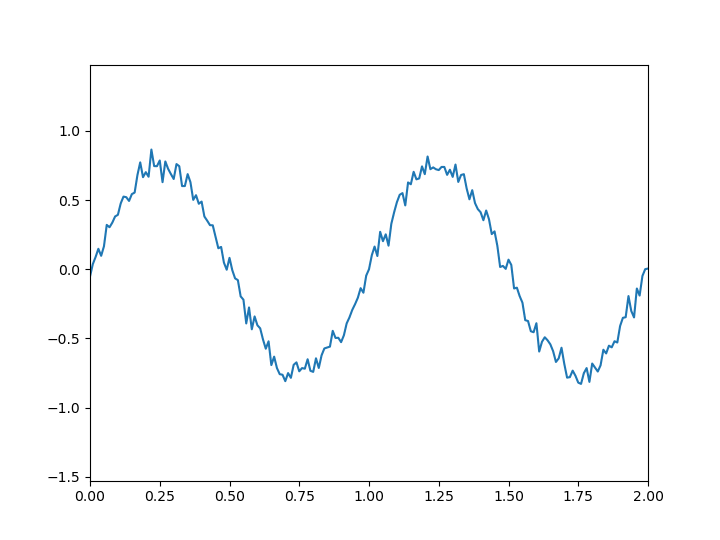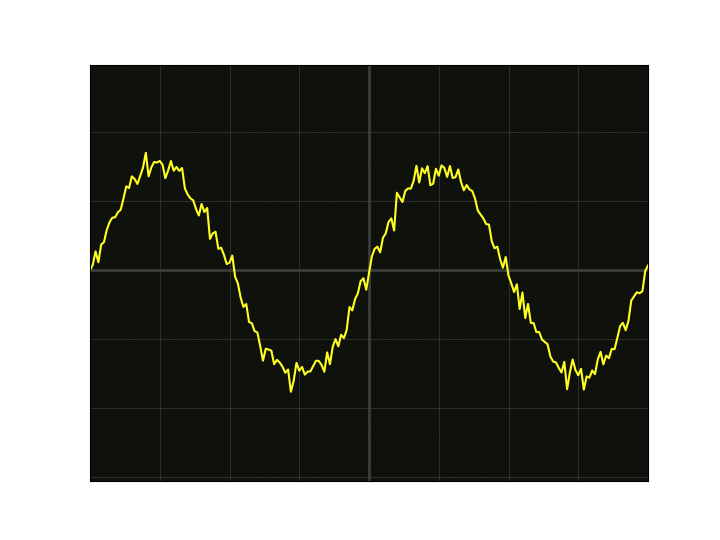Oscilloscope animation of an electric signal in Python
Question:
Good evening,
I am new to Python. I am trying to process a signal saved in a npy file.
This file contains an electrical signal that I want to view as I do in the laboratory with the oscilloscope, so I want to generate an animation that shows me how the signal changes over time.
Here is my attempt:
import numpy as np
import matplotlib.pyplot as plt
from matplotlib.animation import FuncAnimation
signal = np.load('signal.npy')
fig = plt.figure()
def animation(i):
plt.cla()
plt.plot(signal)
# what to do here?
anim = FuncAnimation(fig, animation, frames = len(signal), interval = 10)
plt.show()
I have no idea what to do in the animation function.
Thanks in advance and sorry for my english
Answers:
In the matplotlib documentation you can see an example of a simulation of an oscilloscope here
Since I do not have access to your signal data, I generate mine in order to run the animation. Replace my random signal with yours.
A basic code to view you signal with respect to time could be this:
# import
import numpy as np
import matplotlib.pyplot as plt
from matplotlib.animation import FuncAnimation
# signal generation
N = 10001
stop = 100
time = np.linspace(0, stop, N)
A = 1/4*np.cos(2*np.pi*(np.abs(time - stop/2)/stop)) + 1
f = np.concatenate((1*np.ones(int(N/4)), 2*np.ones(int(N/2) + 1), 1*np.ones(int(N/4))))
signal = A * np.sin(2*np.pi*f*time) + 0.05*np.random.randn(N)
# figure preparation
fig, ax = plt.subplots(1, 1, figsize = (8*0.9, 6*0.9))
displayed_period = int(2*f.min())
span = int(N/stop/f.min())
def animation(i):
# delete previous frame
ax.cla()
# plot and set axes limits
ax.plot(time[span*i: 1 + span*(i + displayed_period)],
signal[span*i: 1 + span*(i + displayed_period)])
ax.set_xlim([time[span*i], time[span*(i + displayed_period)]])
ax.set_ylim([1.1*signal.min(), 1.1*signal.max()])
# run animation
anim = FuncAnimation(fig, animation, frames = int(len(time)/span - 1), interval = 10)
plt.show()
which gives this animation:
Explanation
In my case, the signal is a sine wave which changes amplitude and frequency over time (plus some noise). I choose to see two complete oscillations of my signal per each frame, so I set
displayed_period = int(2*f.min())
to be sure to see at least the two complete oscillations. Then I have to define the amount of time passed through x axis between a frame and the following, so I set:
span = int(N/stop/f.min())
That being said, when you run the code, the animation function is called multiple times, in each time the i counter increases by 1. So you can use this counter to slice the time and the signal arrays: time[span*i: 1 + span*(i + displayed_period)].
In this way you plot a displayed_period number of complete oscillations and, for each frame, you scroll the x axis by span element.
You have to set displayed_period and span according to your signal properties in order to get a similar result.
If you want a little bit customization like an oscilloscope, check this code:
# import
import numpy as np
import matplotlib.pyplot as plt
from matplotlib.animation import FuncAnimation
# signal generation
N = 10001
stop = 100
time = np.linspace(0, stop, N)
A = 1/4*np.cos(2*np.pi*(np.abs(time - stop/2)/stop)) + 1
f = np.concatenate((1*np.ones(int(N/4)), 2*np.ones(int(N/2) + 1), 1*np.ones(int(N/4))))
signal = A * np.sin(2*np.pi*f*time) + 0.05*np.random.randn(N)
# color definition
black = '#0F110D'
grey = '#3B3D3A'
yellow = '#FFFF21'
# figure preparation
fig, ax = plt.subplots(1, 1, figsize = (8*0.9, 6*0.9))
displayed_period = int(2*f.min())
span = int(N/stop/f.min())
def animation(i):
# delete previous frame
ax.cla()
# set background color and plot
ax.set_facecolor(black)
ax.plot(time[span*i: 1 + span*(i + displayed_period)],
signal[span*i: 1 + span*(i + displayed_period)],
color = yellow)
# plot axes lines
ax.hlines(y = 0,
xmin = 0,
xmax = stop,
lw = 2,
colors = grey)
ax.vlines(x = time[int(span*i + (1 + span*displayed_period)/2)],
ymin = 1.1*signal.min(),
ymax = 1.1*signal.max(),
lw = 2,
colors = grey)
# set grid, axes limits and ticks
ax.grid(which = 'major',
ls = '-',
lw = 0.5,
color = grey)
ax.set_xlim([time[span*i], time[span*(i + displayed_period)]])
ax.set_ylim([1.1*signal.min(), 1.1*signal.max()])
plt.tick_params(axis = 'both',
which = 'both',
bottom = False,
left = False,
labelbottom = False,
labelleft = False)
# run animation
anim = FuncAnimation(fig, animation, frames = int(len(time)/span - 1), interval = 10)
anim.save('oscilloscope.gif', writer = 'imagemagick')
plt.show()
I do not changed the functionalities, only the aspect of the animation:
Good evening,
I am new to Python. I am trying to process a signal saved in a npy file.
This file contains an electrical signal that I want to view as I do in the laboratory with the oscilloscope, so I want to generate an animation that shows me how the signal changes over time.
Here is my attempt:
import numpy as np
import matplotlib.pyplot as plt
from matplotlib.animation import FuncAnimation
signal = np.load('signal.npy')
fig = plt.figure()
def animation(i):
plt.cla()
plt.plot(signal)
# what to do here?
anim = FuncAnimation(fig, animation, frames = len(signal), interval = 10)
plt.show()
I have no idea what to do in the animation function.
Thanks in advance and sorry for my english
In the matplotlib documentation you can see an example of a simulation of an oscilloscope here
Since I do not have access to your signal data, I generate mine in order to run the animation. Replace my random signal with yours.
A basic code to view you signal with respect to time could be this:
# import
import numpy as np
import matplotlib.pyplot as plt
from matplotlib.animation import FuncAnimation
# signal generation
N = 10001
stop = 100
time = np.linspace(0, stop, N)
A = 1/4*np.cos(2*np.pi*(np.abs(time - stop/2)/stop)) + 1
f = np.concatenate((1*np.ones(int(N/4)), 2*np.ones(int(N/2) + 1), 1*np.ones(int(N/4))))
signal = A * np.sin(2*np.pi*f*time) + 0.05*np.random.randn(N)
# figure preparation
fig, ax = plt.subplots(1, 1, figsize = (8*0.9, 6*0.9))
displayed_period = int(2*f.min())
span = int(N/stop/f.min())
def animation(i):
# delete previous frame
ax.cla()
# plot and set axes limits
ax.plot(time[span*i: 1 + span*(i + displayed_period)],
signal[span*i: 1 + span*(i + displayed_period)])
ax.set_xlim([time[span*i], time[span*(i + displayed_period)]])
ax.set_ylim([1.1*signal.min(), 1.1*signal.max()])
# run animation
anim = FuncAnimation(fig, animation, frames = int(len(time)/span - 1), interval = 10)
plt.show()
which gives this animation:
Explanation
In my case, the signal is a sine wave which changes amplitude and frequency over time (plus some noise). I choose to see two complete oscillations of my signal per each frame, so I set
displayed_period = int(2*f.min())
to be sure to see at least the two complete oscillations. Then I have to define the amount of time passed through x axis between a frame and the following, so I set:
span = int(N/stop/f.min())
That being said, when you run the code, the animation function is called multiple times, in each time the i counter increases by 1. So you can use this counter to slice the time and the signal arrays: time[span*i: 1 + span*(i + displayed_period)].
In this way you plot a displayed_period number of complete oscillations and, for each frame, you scroll the x axis by span element.
You have to set displayed_period and span according to your signal properties in order to get a similar result.
If you want a little bit customization like an oscilloscope, check this code:
# import
import numpy as np
import matplotlib.pyplot as plt
from matplotlib.animation import FuncAnimation
# signal generation
N = 10001
stop = 100
time = np.linspace(0, stop, N)
A = 1/4*np.cos(2*np.pi*(np.abs(time - stop/2)/stop)) + 1
f = np.concatenate((1*np.ones(int(N/4)), 2*np.ones(int(N/2) + 1), 1*np.ones(int(N/4))))
signal = A * np.sin(2*np.pi*f*time) + 0.05*np.random.randn(N)
# color definition
black = '#0F110D'
grey = '#3B3D3A'
yellow = '#FFFF21'
# figure preparation
fig, ax = plt.subplots(1, 1, figsize = (8*0.9, 6*0.9))
displayed_period = int(2*f.min())
span = int(N/stop/f.min())
def animation(i):
# delete previous frame
ax.cla()
# set background color and plot
ax.set_facecolor(black)
ax.plot(time[span*i: 1 + span*(i + displayed_period)],
signal[span*i: 1 + span*(i + displayed_period)],
color = yellow)
# plot axes lines
ax.hlines(y = 0,
xmin = 0,
xmax = stop,
lw = 2,
colors = grey)
ax.vlines(x = time[int(span*i + (1 + span*displayed_period)/2)],
ymin = 1.1*signal.min(),
ymax = 1.1*signal.max(),
lw = 2,
colors = grey)
# set grid, axes limits and ticks
ax.grid(which = 'major',
ls = '-',
lw = 0.5,
color = grey)
ax.set_xlim([time[span*i], time[span*(i + displayed_period)]])
ax.set_ylim([1.1*signal.min(), 1.1*signal.max()])
plt.tick_params(axis = 'both',
which = 'both',
bottom = False,
left = False,
labelbottom = False,
labelleft = False)
# run animation
anim = FuncAnimation(fig, animation, frames = int(len(time)/span - 1), interval = 10)
anim.save('oscilloscope.gif', writer = 'imagemagick')
plt.show()
I do not changed the functionalities, only the aspect of the animation:

